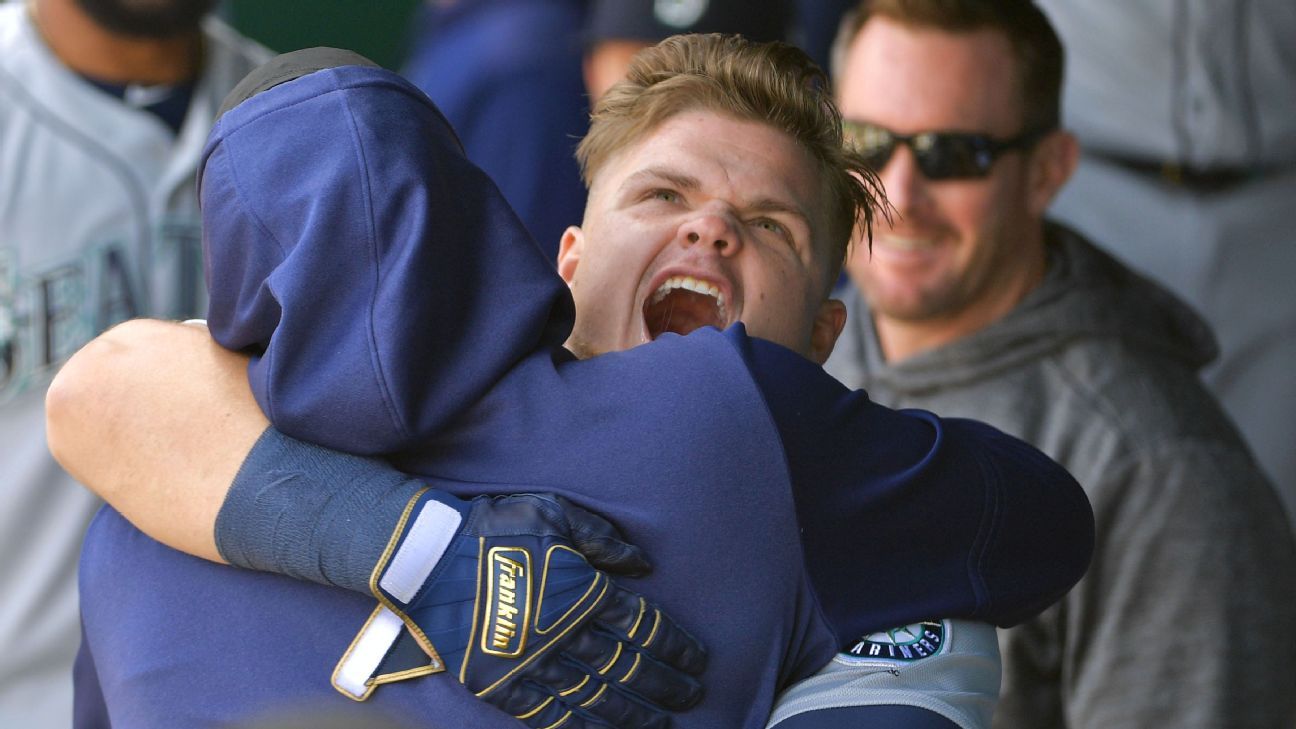KANSAS CITY, Mo. — In the simple telling of this beyond-real Seattle Mariners story, Daniel Vogelbach plays the large adult son. He stands 6-foot, with the round face of a South Park character, the torso of a quarter-barrel keg and the goofy countenance of Chris Farley. He swings his bat with vigor and hits baseballs extraordinarily hard. Vogelbach is easy to love and easier to stereotype. He is, in those ways and many more, a microcosm of his team.
All it takes to see the real Vogelbach, the one who shall not be reduced to a cartoon, is a trip to the Mariners’ clubhouse on a Thursday morning. It’s 9 o’clock, nearly seven hours before Vogelbach will hit a go-ahead home run in extra innings to win another game for the Mariners. Most of baseball is asleep. Seattle’s veterans are hopping the second bus from the team hotel. Vogelbach moseys over to an empty seat, plops in front of a computer and starts to watch video. And then he watches more video. And when he has had enough, he points and clicks some more.
It is not an accident that Vogelbach, 26, seemingly a big leaguer for good after destroying minor league pitching seven years running, has carved out a place on this record-setting Mariners team — the one with a 13-2 record, home runs in all 15 of its games and playoff aspirations in what was supposed to be a rebuilding year. He may look like a meathead. In truth, he’s a complete egghead.
Vogelbach’s memory for baseball minutiae is encyclopedic. He knows what pitchers throw, how the pitches spin, their movement profiles. He knows how they will pitch him. He knows this because he’s self-aware enough to understand how baseball people discount him because of his body and foot speed and all the gifts he wasn’t given. So he must be smarter. He must work harder. He must approach baseball with the reverence and respect something so difficult warrants.
“It’s not an easy game,” Vogelbach says. “You can’t take any days off, for granted. It’s just trying every day to come in. You’re not always going to get hits, but at least you can control your at-bats. If you’re not feeling it, you can battle, grind at-bats out. In an 0-for-4, you can still do things to help your team win. I’m a firm believer in that.
“Every time I get in the box, it’s a refreshing moment. You control what you can control.”
What he’s controlling is practically everything, though particularly the strike zone. And that is the hub of this remarkable 15-game run by the Mariners: the not-so-novel-but-supremely-novel-to-them talking point of controlling the zone. Manager Scott Servais preaches it like he’s a minister and the 17-inch-wide plate is his pulpit. Jay Bruce and Edwin Encarnacion, two of the new-look Mariners’ offseason additions, are his evangelists — Bruce via word throughout the clubhouse, Encarnacion via action in-game. And the rest of the congregants — Vogelbach and Domingo Santana and Tim Beckham and Ryon Healy and Dee Gordon and Mallex Smith — are just happy to embody the gospel on the way to 117 runs scored and a staggering plus-42 run differential.
“You’re always trying to get better,” Servais says. “I know I am. Continuous improvement is one of the things we’ve talked about. Kaizen. Have you ever heard about kaizen?”
Kaizen is the Japanese business tenet of continuous improvement — of increasing productivity through streamlined processes. Servais is a fan of leadership books, and when he read Masaki Imai’s 1986 tome about kaizen this offseason, he believed its ability to improve all aspects of a business, from management to rank-and-file, could benefit a Mariners team that traded away its best pitcher (James Paxton), its star closer (Edwin Diaz), its high-priced second baseman (Robinson Cano) and other core players.
The Mariners rebuilt their offense with the intent of bullying pitchers. In the past, the advance reports given to hitters before the game consisted of the velocity range of opponents’ pitches and the movement patterns. This season, Seattle installed a pair of analysts in the clubhouse to serve as conduits for much deeper information. It’s no longer merely opposing pitchers’ stuff. Mariners hitters are essentially given game-planning techniques — not just what pitchers throw but what they throw that gets hit hard.
“It’s more sophisticated, but it’s actually simpler, if that makes any sense,” says Mitch Haniger, the longest-tenured active Mariners hitter who, like Vogelbach, is a deeply analytical and thoughtful hitter. “You’re getting more information, but they’re telling you exactly where to focus to do damage.”
It has manifested itself in myriad ways. This goes beyond the simple patience they’ve shown. Yes, Mariners hitters are swinging at just 23.7 percent of pitches outside the strike zone, per ESPN Stats & Information research, the fifth lowest rate in baseball. And a year after seeing 3.79 pitches per plate appearance, they’re at 4.06 this year. Now is perhaps the best time for the small-sample caveat. Fifteen games do not a season make. But it’s the second-level statistics that are truly indicative of a team with deep improvements: When Mariners hitters are behind in counts (0-1, 0-2 and 1-2), they’ve swung at just 43.7 percent of pitches, well below the MLB average of nearly 50 percent. Their patience does not wane in stressful situations.
“No one’s wasting any at-bats,” Beckham says. “But it’s early. There are 150 more games to go. We haven’t accomplished anything.”
Let’s not go that far. The Mariners are only the 17th team since the turn of the 20th century to start a season at least 13-2. Only three other teams in the wild-card era have done so: the 2018 Red Sox, who won the World Series, and the 2013 Braves and 2003 Giants, both of whom made the playoffs. The Mariners’ 36 home runs are tied for the most ever through 15 games, and their 117 runs rank second.
The individual numbers are equally staggering. Gordon, an inveterate free swinger, is chasing on just 20 percent of outside pitches. Beckham, the former No. 1 overall pick, is walking nearly twice as much as ever, in close to 14 percent of his plate appearances. Bruce has seven home runs in 13 games, nearly matching his total from last season with the Mets. Santana and Encarnacion, also acquired in trades, are putting up matching .300/.400/.500 slash lines from the Nos. 3 and 4 holes.
Nobody is surprising quite like Vogelbach. The Chicago Cubs took him in the second round of the 2011 draft, when he weighed upward of 300 pounds. They believed the bat would play. And it did. Vogelbach always hit. It wasn’t enough. In July 2016, Chicago shipped him to Seattle for Mike Montgomery, who closed out Game 7 of the World Series for the Cubs. Vogelbach debuted and struggled, returned in 2017 and struggled again and didn’t do much in 102 plate appearances last year, either. The up-and-down tends to wear on analytical types, to whom routine is religion.
On April 2, in the Mariners’ eighth game of the year, Vogelbach hit his first home run. In their next game, he hit another. Two days later, two more. A day after that, another. And on Thursday came his sixth homer in 39 plate appearances, one that raised his batting average to .400, his on-base percentage to .513, his slugging percentage to 1.133 and his cult-hero status to the point where Sub Pop should be offering him a record deal any day.
“It’s not gonna last. I understand that,” Vogelbach says. “I try not to ride that roller coaster. If you can stay even-keeled the whole time, through the ups and downs, at the end of the year you’ll be where you want to be.”
And that’s the tack the Mariners are trying to take with this success. Vogelbach knows he’s not going to hit .588 on pitches in the strike zone, no matter how much he controls it. He realizes that he probably won’t finish the season second in the major leagues in average exit velocity behind Aaron Judge.
He understands that for the Mariners to be taken seriously, they must improve on their league-worst defense, which has committed 21 errors, and that their pitching, iffy at best on paper, must overachieve. He recognizes that if the Mariners’ offense really wants some respect on its name, an upcoming three-game stretch could mean even more than the 15 already in the books. On Saturday night, they host Justin Verlander. On Sunday afternoon, it’s Gerrit Cole. And on Monday night, Trevor Bauer.
That’s three consecutive games against the Nos. 2, 5 and 6 finishers in the American League Cy Young voting last season. It’s not a litmus test as much as it is a final at the end of an incredibly successful term. Can these Seattle Mariners do what they’ve done thus far against the best of the best? Is their ability to control the zone something they possess against all calibers of pitchers? Has their kaizen taken them beyond mere novelty and to legitimate AL West threat?
Vogey has an answer to that, much as he has everything thrown his way in 2019. When Vogelbach arrived in the big leagues, Kyle Seager, the Mariners’ longest-tenured player, told him to give every player respect but take the name off the back of his opponents’ jerseys. It’s the same game no matter who’s pitching, Seager said, so there’s no sense in adding pressure by assigning any more import to Verlander or Cole or Bauer or anyone else. He appreciates that it’s not an easy game, not one you take for granted and that the Seattle Mariners, the best team nobody expected, will control only what they can control, which, at least so far, is plenty.

